Having a wide range of effects pedals allows you to transform your tone in seemingly limitless ways. Sometimes, it’s best to run your electric guitar into the clean channel of your amplifier and enjoy the natural tone it produces. Clean boost pedals are designed to ensure that your guitar doesn’t get drowned out. Whether you like to play clean chord sequences, riffs, or solos, it’s important to have the option of boosting your guitar’s output when the need arises.
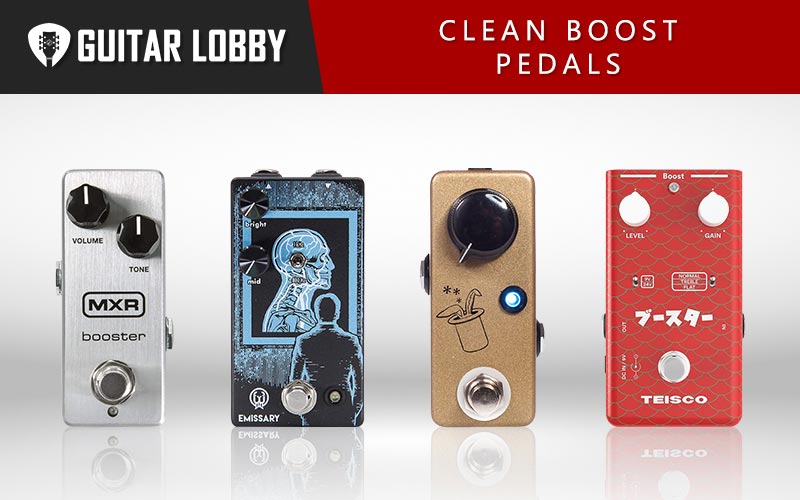
In this guide, we’ll take a look at the best clean boost pedals so that you can find the ideal addition to your pedalboard.
| Name of Product | Image of Product | Description | Price Range | Full Review |
|---|---|---|---|---|
| 1. JHS Prestige (Best Overall) | 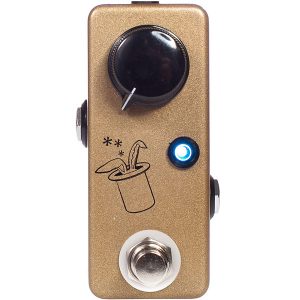 | Type: Analog Effects: Clean Boost | $130 | Read Full Review Below |
| 2. Fender Engager Boost (Best Value) | 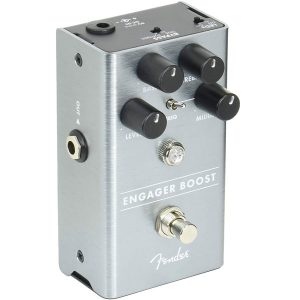 | Type: Analog Effects: Clean Boost, EQ | $110 | Read Full Review Below |
| 3. MXR M133 Micro Amp (Best Under $100) | 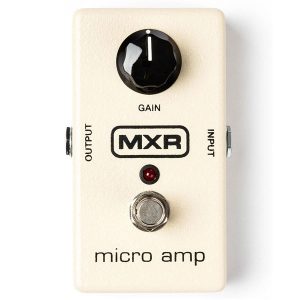 | Type: Analog Effects: Clean Boost | $80 | Read Full Review Below |
| 4. TC Electronic Spark Mini Booster (Best Under $75) | 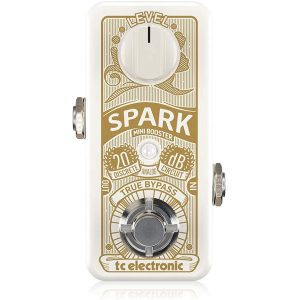 | Type: Analog Effects: Clean Boost | $60 | Read Full Review Below |
| 5. Wampler Decibel Plus V2 | 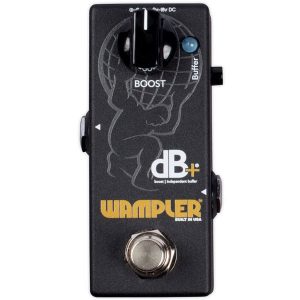 | Type: Analog Effects: Clean Boost | $120 | Read Full Review Below |
| 6. MXR Booster Mini |  | Type: Analog Effects: Clean Boost | $100 | Read Full Review Below |
| 7. Keeley Katana Mini | 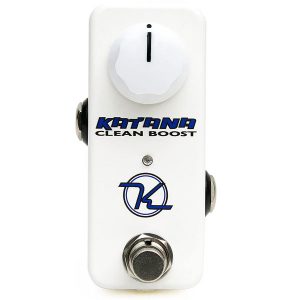 | Type: Analog Effects: Clean Boost | $100 | Read Full Review Below |
| 8. NUX Lacerate Mini | 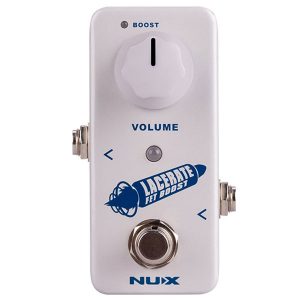 | Type: Analog Effects: Clean Boost | $60 | Read Full Review Below |
| 9. EarthQuaker Devices Arrows | 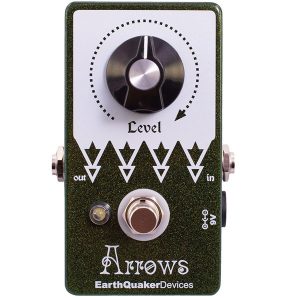 | Type: Analog Effects: Clean Boost | $100 | Read Full Review Below |
| 10. Teisco Boost Pedal | 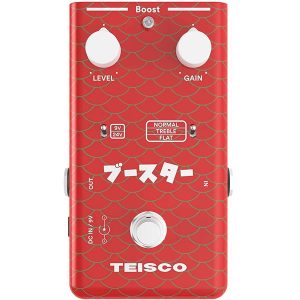 | Type: Analog Effects: Clean Boost | $130 | Read Full Review Below |
| 11. Walrus Audio Emissary | 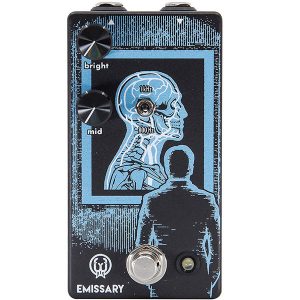 | Type: Analog Effects: Clean Boost, EQ | $170 | Read Full Review Below |
| 12. TC Electronic Spark Booster | 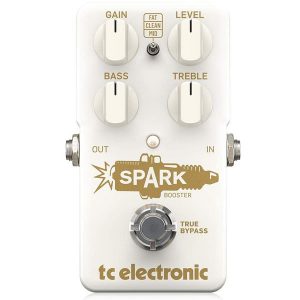 | Type: Analog Effects: Clean Boost, EQ | $75 | Read Full Review Below |
| 13. MXR MC401 | 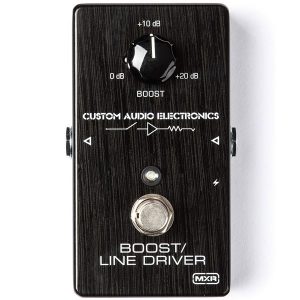 | Type: Analog Effects: Clean Boost | $100 | Read Full Review Below |
| 14. Electro-Harmonix LPB-1 | 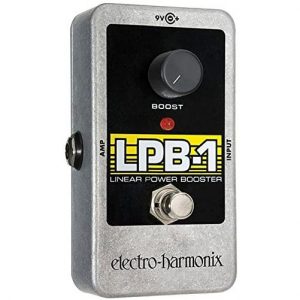 | Type: Analog Effects: Clean Boost | $60 | Read Full Review Below |
| 15. J.Rockett Audio Designs Archer | 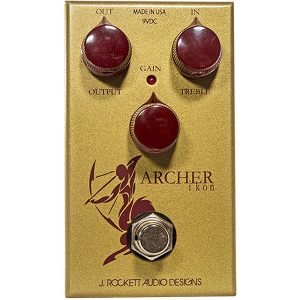 | Type: Analog Effects: Clean Boost, EQ | $190 | Read Full Review Below |
| 16. Xotic EP Booster Mini | 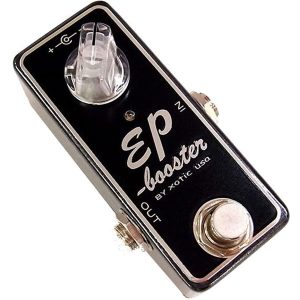 | Type: Analog Effects: Clean Boost, EQ | $130 | Read Full Review Below |
| 17. VSN Booster | 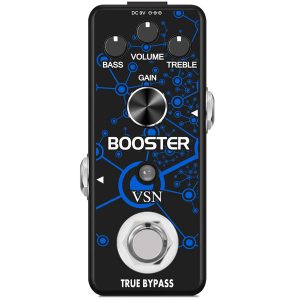 | Type: Analog Effects: Clean Boost, EQ | $30 | Read Full Review Below |
Here Are the Best Clean Boost Guitar Pedals
1. JHS Prestige (Best Overall)
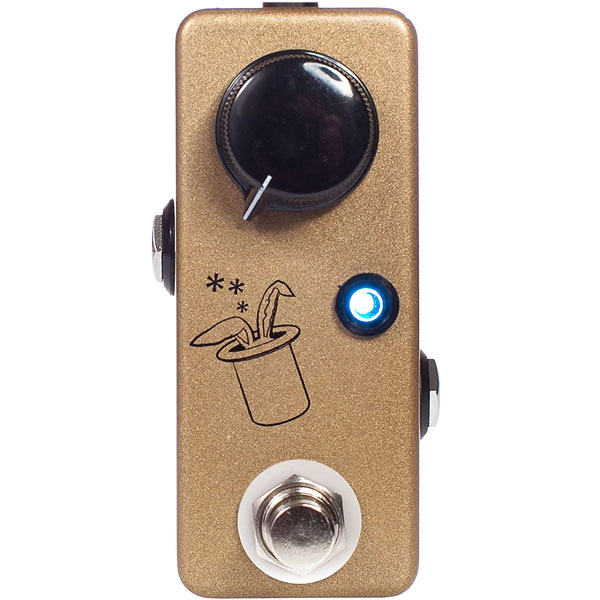
| Estimated Price | $130 |
| Type | Analog |
| Effects | Clean Boost |
| Connectivity | 1 x 6.35mm Jack Input, 1 x Output |
| Power | 9 Volts DC |
My Review: JHS is a relatively new pedal manufacturer, founded in 2007. I’ve been impressed by their growth since then, and their unique stompboxes have gained a reputation for combining simplicity with crisp tonal qualities.
Due to my numerous positive encounters with JHS pedals over the years, I was very eager to test the Prestige. At first glance, I was intrigued by the minimalistic design of this clean boost pedal. It features a singular rotary control, a traditional footswitch, and an LED indicator.
However, despite the simple design of the Prestige, I found that its ability to boost the clean tone of an electric guitar to be highly capable. After experimenting with its position in the signal chain, I found that it works best when placed before any distortion pedals, or within the effects loop of the guitar amp. The tone control can be adjusted so that minimal coloration is added to the signal, allowing the clean sound to cut through the mix with ease.
Who is this best suited for: Clean boost pedals don’t need to be overcomplicated, as JHS has proved with the Prestige stompbox. I believe that this pedal is best suited for guitarists who require a quick and easy way to make their clean tone more prominent.
Bottom Line: The JHS Prestige is a highly versatile boost pedal that can be used to highlight the natural tonal qualities of your electric guitar, or to gently push your preamp tubes in preparation for gain or overdrive pedals.
2. Fender Engager Boost (Best Value)
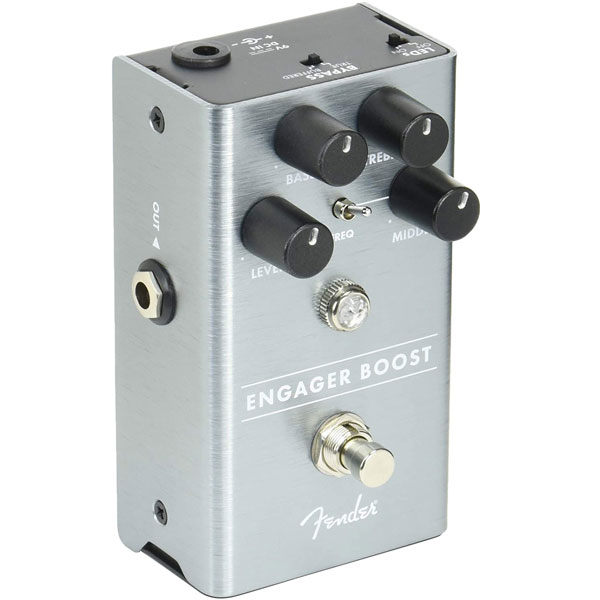
| Estimated Price | $110 |
| Type | Analog |
| Effects | Clean Boost, EQ |
| Connectivity | 1 x 6.35mm Jack Input, 1 x Output |
| Power | 9 Volt |
My Review: I could be accused of being a little biased towards Fender’s pedals, due to my undeniable love for their instruments and amplifiers. Nevertheless, it didn’t take long for me to realize that the Engager Boost is genuinely a great tool for raising the levels of a clean guitar tone regardless of the manufacturer’s reputation.
One of the things that I was instantly impressed by was the detailed array of EQ and dynamic parameters housed on the Engager Boost. While some boost pedals are overcomplicated by having several controls, I found that the four-knob layout of this Fender offering strikes the perfect balance of sonic potential and easy operation.
After experimenting with the Bass, Treble, Middle, and Level controls included on the Engager Boost, I discovered that these settings should be adjusted accordingly when you switch pickup positions or engage other pedals. By tweaking the EQ controls slightly, I was able to maintain a clean and crisp tone whilst adding dynamic power to the signal.
Who is this best suited for: Guitarists who like to control each aspect of their tone will enjoy using the Fender Engager Boost. The extensive EQ section will provide you with a viable method for eliminating any harsh frequencies from your guitar’s clean sound.
Bottom Line: In addition to its distinguished design and robust chassis, the Engager Boost by Fender goes above and beyond the expected capabilities of a clean boost pedal. The frequency switch in the center of the pedal allows you to quickly remove any problematic tones, and the array of tone knobs makes sculpting your clean tone quick and easy. I’d say that overall this is the best clean boost pedal for the money.
3. MXR M133 Micro Amp (Best Under $100)
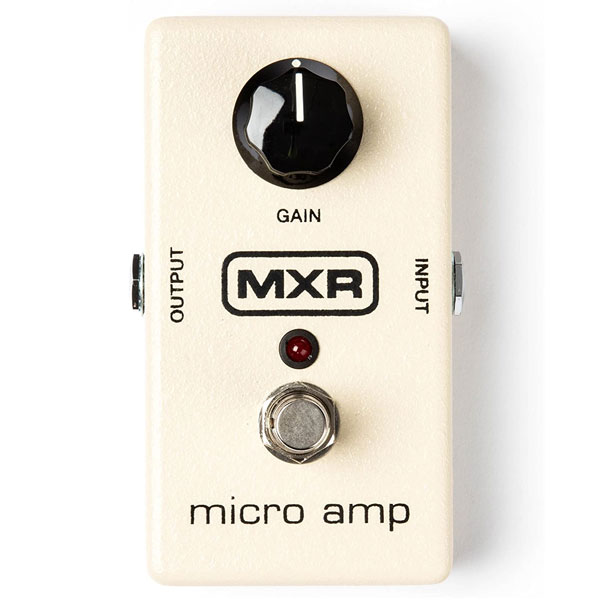
| Estimated Price | $80 |
| Type | Analog |
| Effects | Clean Boost |
| Connectivity | 1 x 6.35mm Jack Input, 1 x Output |
| Power | 9 Volts DC |
My Review: MXR’s M133 Micro Amp may not come with the hefty price tag of many high-end clean boost pedals, but I firmly believe it can compete with the very best in terms of quality and functionality. I found that the biggest strength of this pedal is its ability to add clean-sounding gain to an already desirable amplifier tone.
Upon further analysis, another standout quality that I discovered is the Micro Amp’s ability to operate smoothly within an extensive pedalboard, where long cable runs are necessary. I learned that this is largely a result of the ‘hardwire’ bypass installed by MXR, which exceeds the capabilities of standard true bypass switching in terms of noise reduction and signal clarity.
I also found that this clean boost pedal can be used to add color to your guitar’s tone if required. I was able to achieve a warm, subtle tone simply by setting the singular tone control to around the 3 o’clock position.
Who is this best suited for: The MXR Micro Amp is the type of pedal that every guitarist could benefit from having on their pedalboard. If you’re looking for a quick and easy way to increase the gain of your guitar amp’s clean channel, this affordable device is a must-have.
Bottom Line: Housed in a sturdy metal chassis which is typical of Dunlop-made pedals, and with a simple single-knob layout, the M133 Micro Amp is a highly reliable clean boost stompbox. It is equally suited to be used amidst a crowded pedalboard or as a standalone for making your clean tone more prominent within the mix.
4. TC Electronic Spark Mini Booster (Best Under $75)
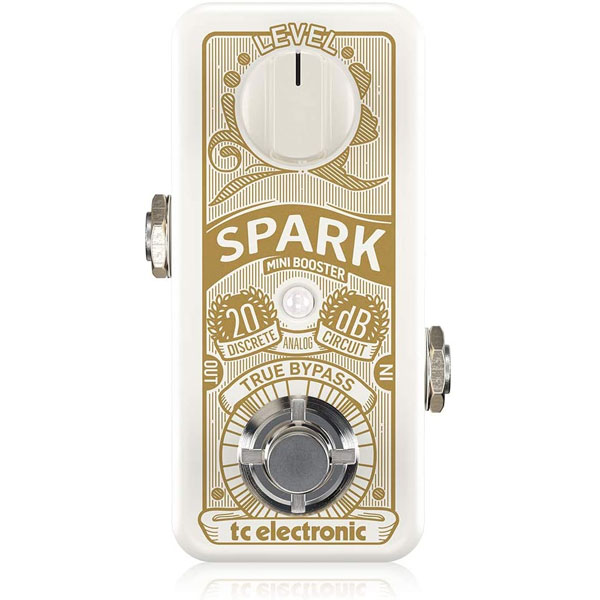
| Estimated Price | $60 |
| Type | Analog |
| Effects | Clean Boost |
| Connectivity | 1 x 6.35mm Jack Input, 1 x Output |
| Power | 9 Volts DC |
My Review: The aforementioned MXR Micro Amp and the Spark Mini Booster by TC Electronic are very similar in layout and performance. However, after taking a closer look at the Spark Mini Booster, I found there to be one key feature that separates it from the rest of the crowd.
When used simply to increase the volume of a clean tone, this pedal is a great tool for crisp funky rhythm guitar, melodic chord sequences, or single-note riffs in the treble end. Furthermore, I was very intrigued by one particular aspect of the pedal – labeled as ‘PrimeTime’.
I had to invest some time into understanding how this feature worked, but eventually, I discovered that it allows the Spark Mini Booster to self-determine whether I wanted to engage the clean boost via a single press of the footswitch or hold it down for the period that I wanted the boost to occur.
Who is this best suited for: The Spark Mini Booster is perfect for guitarists who are looking for a high-performing pedal to add gain to their clean signal spending their entire budget. It’s very easy to use, so if you value simplicity you’ll likely enjoy the minimalistic design of this pedal.
Bottom Line: TC Electronic is amongst the most prolific pedal manufacturers in the world, and it always astonishes me how good their devices are despite their expansive catalog. The Spark Mini Booster can increase the volume of your clean guitar tone by up to 20dB, which is more than adequate for live and studio environments.
5. Wampler Decibel Plus V2
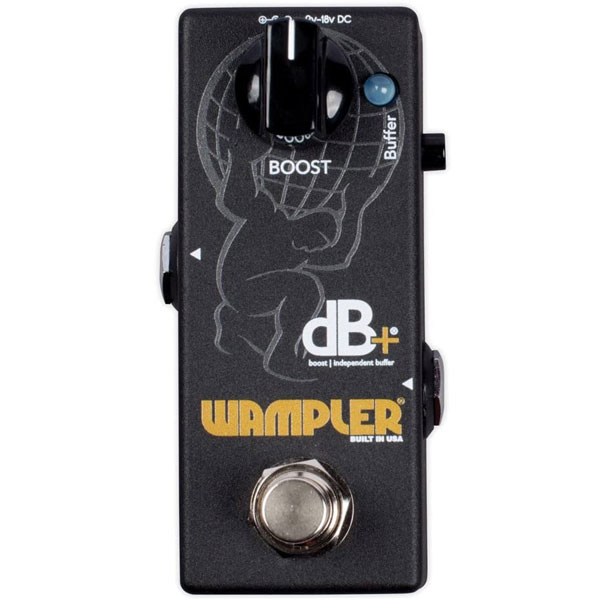
| Estimated Price | $120 |
| Type | Analog |
| Effects | Clean Boost |
| Connectivity | 1 x 6.35mm Jack Input, 1 x Output |
| Power | 9 Volts DC |
My Review: Whenever I hear the term ‘boutique’ used to describe guitar pedals, I can’t help but feel slightly skeptical. Some of these pedal manufacturers tend to go overboard with additional controls and features to make their devices stand out.
Wampler, on the other hand, is one of the few brands that I would argue deserves the boutique label. Despite being relatively new in the pedal manufacturing world, the American company has quickly gained a reputation for producing impeccable devices which add new dimensions to the tone of an electric guitar.
The aptly named Decibel Plus V2 improves upon the previous version, mainly due to the inclusion of a high-quality buffer that maximizes signal strength and clarity. This pedal is extremely easy to use and produces a transparent boost that doesn’t alter the sound of your amp’s clean channel.
Who is this best suited for: The Decibel Plus V2 by Wampler is well suited to guitarists who appreciate well-made, well-designed pedals. Handmade in the USA, this pedal is very robust and therefore may be of interest to touring musicians who are likely to use it heavily on the road.
Bottom Line: Not only is the DB+ V2 a capable clean boost pedal but it can also be used as a buffer to ensure the integrity of your signal as it moves through the chain. It’s very easy to operate and ensures that noise issues don’t tarnish the clarity of your clean guitar tone.
6. MXR Booster Mini
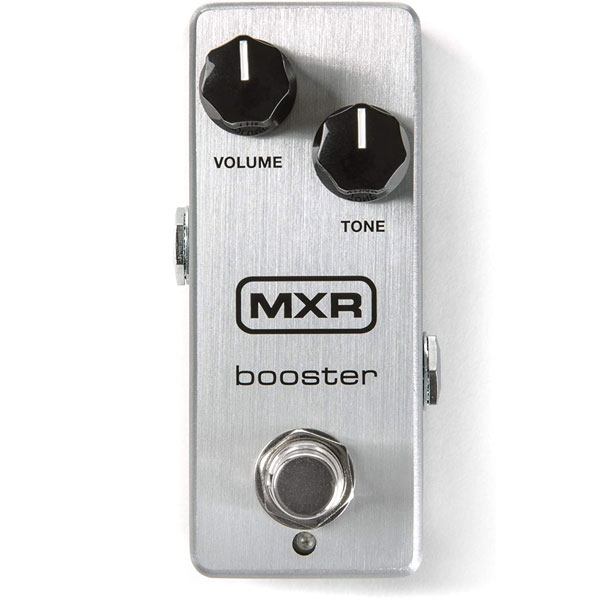
| Estimated Price | $100 |
| Type | Analog |
| Effects | Clean Boost |
| Connectivity | 1 x 6.35mm Jack Input, 1 x Output |
| Power | 9 Volts DC |
My Review: Compared to the MXR Micro Amp which I mentioned earlier, the Booster Mini is capable of an additional 5dB increase in volume. 25 dB is enough to gain to propel your guitar’s clean tone above the mix no matter how heavy the rhythm section in your band plays!
I found that after a little while experimenting with the dual-control layout of the Booster Mini, it is very easy to find the perfect balance between volume and tone. By gradually increasing the volume control, then adding a little more tone, you can ensure that you don’t obscure your clean amp channel’s output too much when the pedal is in use.
Who is this best suited for: The MXR Booster Mini is a great tool for guitarists who often find that their clean tone gets drowned out by other members of their band or a backing track. It’s easy to operate, so you don’t need any prior experience with a clean boost pedal to use it right away.
Bottom Line: Offering an impressive 25 dB of boost, this MXR pedal combines the functions of a clean boost pedal and a preamp device. With true bypass switching, you can rest assured that this pedal will maintain your signal strength and keep noise issues at bay.
7. Keeley Katana Mini
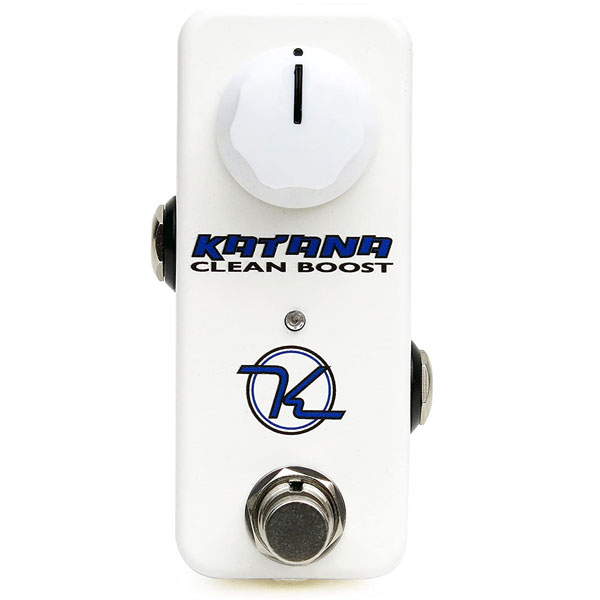
| Estimated Price | $100 |
| Type | Analog |
| Effects | Clean Boost |
| Connectivity | 1 x 6.35mm Jack Input, 1 x Output |
| Power | 9 Volts DC |
My Review: I’d heard many positive things about the full-sized Keeley Katana, and therefore I was excited to check out this newly designed mini version. The first thing I noticed about this pedal was its transparency, which makes it ideal for increasing the volume of clean chord sequences or lead melodies.
Unlike other boost pedals which add a touch of gain and coloration to the signal, the Katana-Mini produces a pure reflection of the combination between an electric guitar and amp. This allows you to push your guitar to the top of the mix without compromising on its tonal qualities.
Who is this best suited for: I’d highly recommend the Mini Katana Boost to any guitarists who play in the style of funk, blues, soul, or classic rock. If you like to use your amp’s clean channel often, this pedal is a perfect match for your needs.
Bottom Line: Although this Keeley pedal is minute in size, its inner circuitry is just as powerful as the full-sized model’s. The Mini Katana Boost lets your clean tone breathe without smothering any of the natural harmonics, whilst increasing the gain significantly.
8. NUX Lacerate Mini
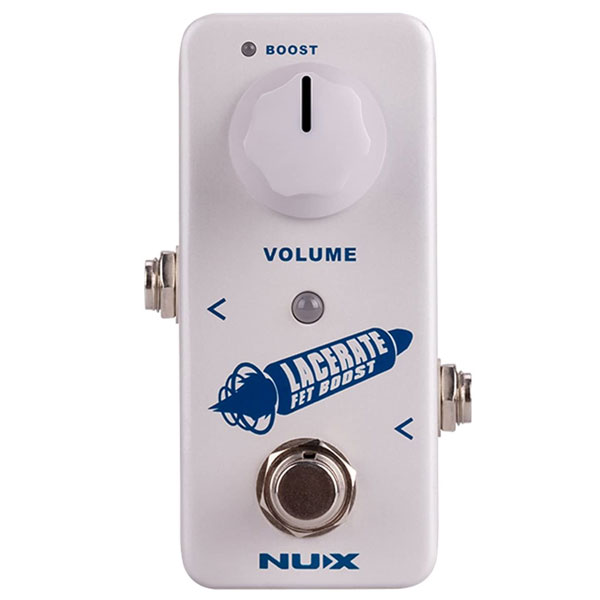
| Estimated Price | $60 |
| Type | Analog |
| Effects | Clean Boost |
| Connectivity | 1 x 6.35mm Jack Input, 1 x Output |
| Power | 9 Volts DC |
My Review: The Lacterate Mini by NUX is another example of this budding manufacturer’s expertise in the field of dynamic-based pedals. It features two boost modes, ‘Clean’ and ‘Crank’. After checking both of these modes out, I found that they provide a good amount of tonal diversity.
For simply adding gain to your clean channel, the ‘Clean’ mode works perfectly. It produces a carbon copy of your natural clean tone, which can then be adjusted using the pots on your guitar or the onboard controls on your amplifier.
Who is this best suited for: I believe that the Lacerate Mini will be a useful addition to guitarist’s pedalboards if they’re looking for a simple and reliable clean boost pedal. There are no unnecessary controls included on this NUX device, so if you value ease of use, this is worth considering.
Bottom Line: The NUX Lacerate Mini is like a smaller version of the revered MXR Micro Boost which was featured earlier in this list. It manages to provide reliable clean boosts without overcomplicating things.
9. EarthQuaker Devices Arrows
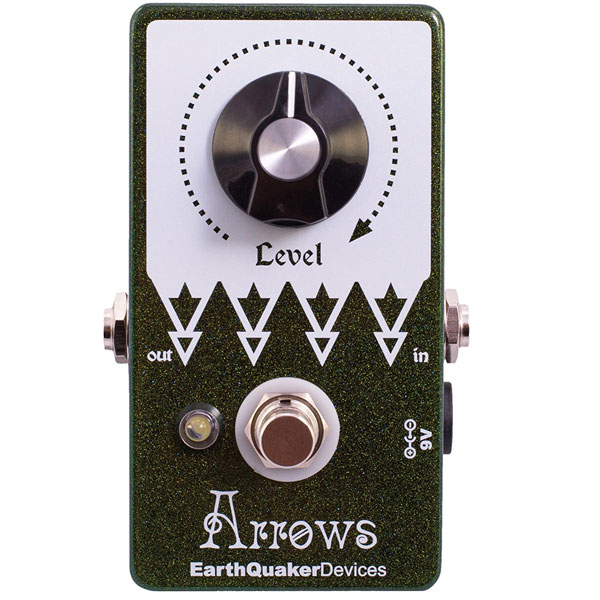
| Estimated Price | $100 |
| Type | Analog |
| Effects | Clean Boost |
| Connectivity | 1 x 6.35mm Jack Input, 1 x Output |
| Power | 9 Volts DC |
My Review: Right off the bat I could tell that the Arrows clean boost pedal by EarthQuaker Devices was built to a very high standard. I learned that not only does this pedal provide a transparent boost, but it is also effective for driving the preamps in a tube amplifier to the point of saturation.
The standout quality of this stylish stompbox is its noiseless operation. Thanks to the inclusion of soft-touch, relay-based circuitry, the pedal can boost your guitar’s clean tone without amplifying any electrical noises caused by the signal chain.
Who is this best suited for: If you’re a fan of distinguished designs and simple functionality, you’ll enjoy the Arrows clean boost pedal by EarthQuaker Devices.
Bottom Line: Whether you position it in the effects loop of your amplifier or front of your overdrive pedal, the Arrows will boost your clean guitar tone without any issues. This versatile pedal is also great for ensuring your melodies and solos rise above the mix and are heard by the audience.
10. Teisco Boost Pedal
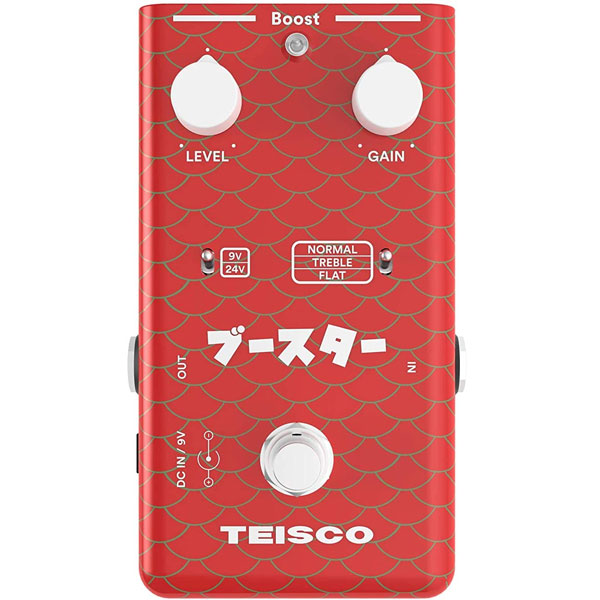
| Estimated Price | $130 |
| Type | Analog |
| Effects | Clean Boost |
| Connectivity | 1 x 6.35mm Jack Input, 1 x Output |
| Power | 9 Volts DC |
My Review: Compared to most of the other clean boost pedals featured on this list, this Tiesco device offers more tonal and dynamic options. I like the design of the pedal, with its distinctively vintage imagery, fonts, and layout.
By using the three-way toggle switch, I found that the ‘Normal’ mode is best for boosting a clean guitar tone. ‘Treble’ is useful if you’re trying to draw attention to the high-end frequencies in chords or melodies, and ‘Flat’ is useful for reducing any harshness from your guitar’s output.
Who is this best suited for: The Boost Pedal by Teisco is a great option for guitarists who are also considering acquiring an overdrive and EQ device. This three-in-one pedal can be used as a simple clean boost, or you could employ it for adding gain to your signal.
Bottom Line: Offering plenty of headroom, the Teisco Boost is designed to resemble classic boost pedals of decades gone by. It features several adjustable features that you can use to tailor its performance to your liking, both tonally and dynamically.
11. Walrus Audio Emissary
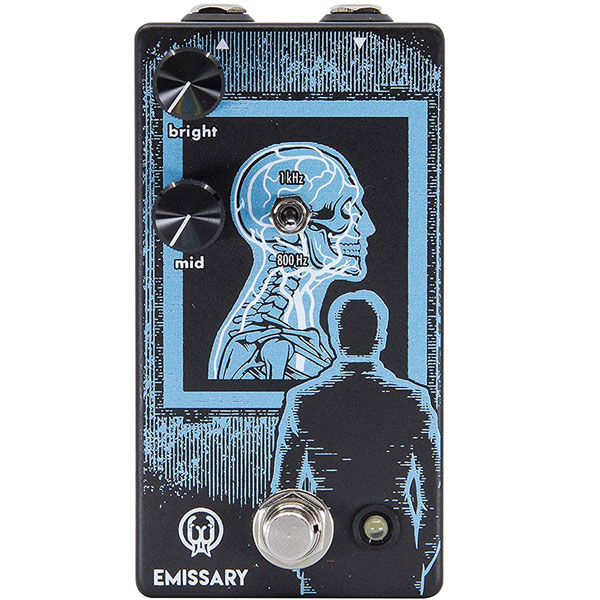
| Estimated Price | $170 |
| Type | Analog |
| Effects | Clean Boost, EQ |
| Connectivity | 1 x 6.35mm Jack Input, 1 x Output |
| Power | 9 Volts DC |
My Review: In contrast to stereotypical boost pedals, the Emissary by Walrus Audio aims to raise the output of your amplifier without adding gain. It does this through a process known as parallel boosting, with a pair of circuits included within the pedal.
One of these circuits is of the classic JFET variety, which produces a bright and sparkling boost. The other circuit, labeled as ‘Mid’, is much more powerful. It targets the midrange frequencies of the guitar, which make up the majority of your clean tone.
Who is this best suited for: If you’re interested in sculpting your own boosted tones using onboard controls, you’ll enjoy the freedom that the Emissary by Walrus Audio offers.
Bottom Line: With two separate circuits that can be used either as standalone or parallel to one another, the Emissary clean boost pedal is a unique offering. It blends the worlds of EQ and boost pedals, and increases the number of options you have at your disposal.
12. TC Electronic Spark Booster
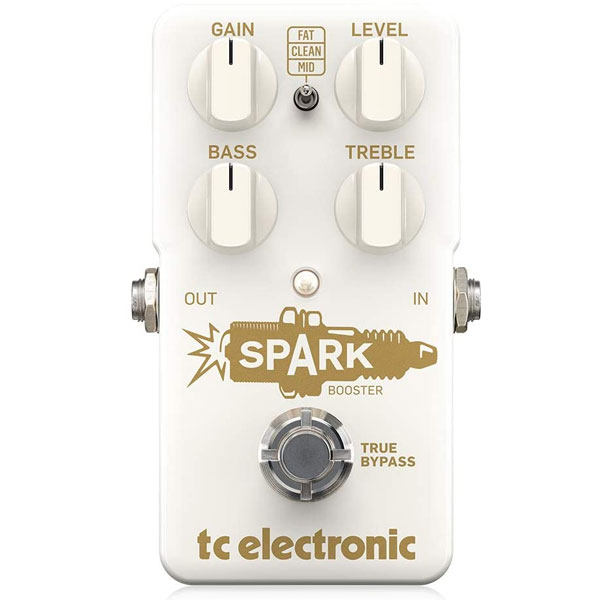
| Estimated Price | $75 |
| Type | Analog |
| Effects | Clean Boost, EQ |
| Connectivity | 1 x 6.35mm Jack Input, 1 x Output |
| Power | 9 Volts DC |
My Review: Earlier in this article I drew your attention to the brilliant Spark Booster Mini. This is the full-sized version and is one of TC Electronic’s best-selling stompboxes. It offers the same transparent clean boost as the smaller edition but expands the number of adjustable parameters you can use to sculpt your dynamics and tone.
This pedal is in my opinion, closer to a preamp than a traditional boost device. It allows you to control the volume of the inputted signal and the outputted signal so that you can compensate for any tonal changes made during the boost process.
Who is this best suited for: If you’d like to have complete control over the level that your clean guitar tone is boosted too, and the core frequencies that make up the boosted signal, the Spark Booster may very well be the perfect choice for you.
Bottom Line: With its extensive four-knob layout, a three-way toggle switch with presets that adjust the brightness of your guitar’s output, and reliable true bypass switching, the TC Electronic Spark Booster is one of the best clean boost pedals on the market.
13. MXR MC401
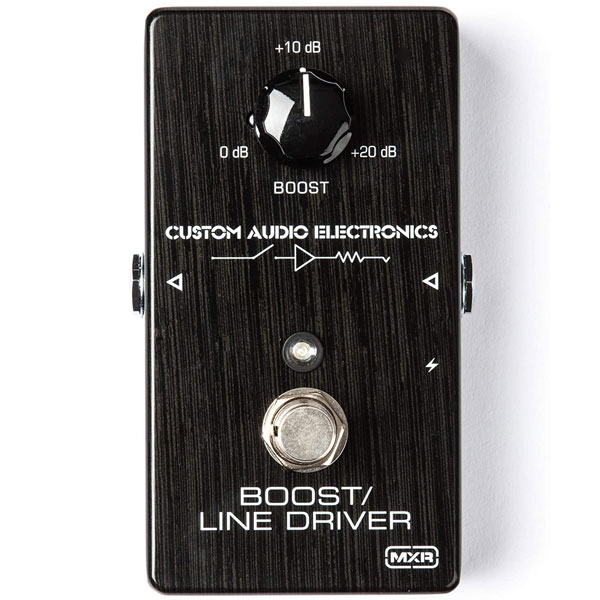
| Estimated Price | $100 |
| Type | Analog |
| Effects | Clean Boost |
| Connectivity | 1 x 6.35mm Jack Input, 1 x Output |
| Power | 9 Volts DC |
My Review: After testing the MXR MC401, I was highly impressed by the amount of clean boost this pedal provides without heavily altering the guitar’s tone. It injects dynamic energy into the signal and is very easy to operate.
The circuitry used by MXR is specifically designed to reduce noise issues when the gain is applied to the guitar’s signal. Even when the full 20 dB boost is applied, I found that this pedal preserves the tonal qualities of a clean guitar.
Who is this best suited for: The MXR MC401 is a good match for musicians who are looking to increase the volume of their clean tone considerably, without compromising on brightness or clarity.
Bottom Line: Whether you use it as a standalone boost or in conjunction with an overdrive pedal, the MC401 is a great tool for increasing the prominence of your clean electric guitar tone. The single-knob layout makes this pedal very easy to use, and its reliable circuitry ensures smooth performance.
14. Electro-Harmonix LPB-1
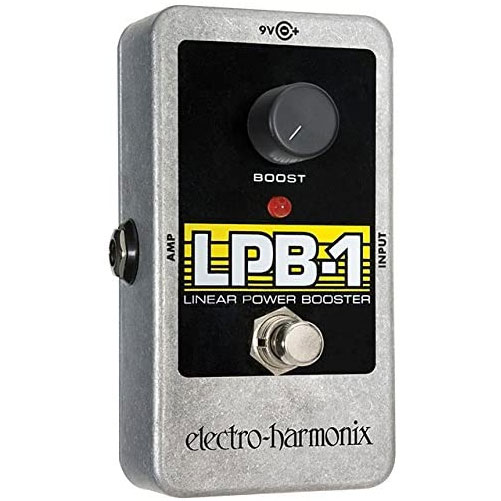
| Estimated Price | $60 |
| Type | Analog |
| Effects | Clean Boost |
| Connectivity | 1 x 6.35mm Jack Input, 1 x Output |
| Power | 9 Volts DC |
My Review: I’ve relied on Electro-Harmonix pedals heavily throughout my time as a guitarist, and therefore I’m always excited by the prospect of putting one of their stompboxes to the test.
The LPB-1 is a simple, straightforward boost pedal. Its only rotary control can be used to increase or decrease the amount of boost that is added to the clean guitar signal. Like all EHX pedals, it’s built like a tank!
Who is this best suited for: With its simplistic design, the LPB-1 by Electro Harmonix is a great choice for guitarists who don’t want to waste time adjusting various parameters and would rather get back to playing as soon as possible!
Bottom Line: EHX pedals are built to a very high standard. The LPB-1 is their flagship clean boost offering, with true bypass switching ensuring your signal integrity remains firmly intact.
15. J.Rockett Audio Designs Archer
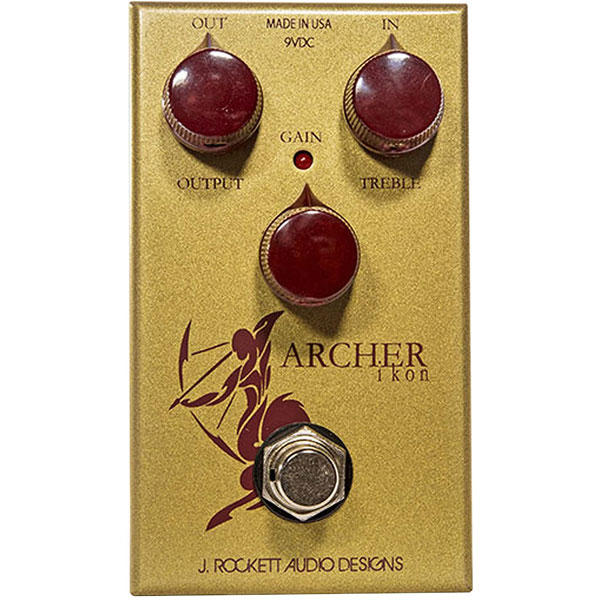
| Estimated Price | $190 |
| Type | Analog |
| Effects | Clean Boost, EQ |
| Connectivity | 1 x 6.35mm Jack Input, 1 x Output |
| Power | 9 Volts DC |
My Review: I’m aware that the Archer by J.Rockett Audio Designs is perhaps more of an overdrive pedal than a clean boost device. However, I’ve included it in this list because it can indeed be used as a boost pedal, and it performs very capably in this role.
J.Rockett Audio Designs is very closely linked to Bill Finnegan, who invented the legendary Klon. This pedal takes inspiration from his creation, offering warm overdrive and a notable dynamic boost for your lead and rhythm guitar parts.
Who is this best suited for: The Archer is a great choice for those who are fans of the iconic Klon pedal. If you’re considering purchasing an overdrive as well as a clean boost, you can save yourself money and effort by choosing the J.Rockett Archer.
Bottom Line: Housed in a solid steel chassis, the Archer by J.Rockett Audio Designs combines durability and sonic quality. It features a classic dual op-amp, germanium clipping diode, and buffered circuitry format for adding gain to the electric guitar’s signal.
16. Xotic EP Booster Mini
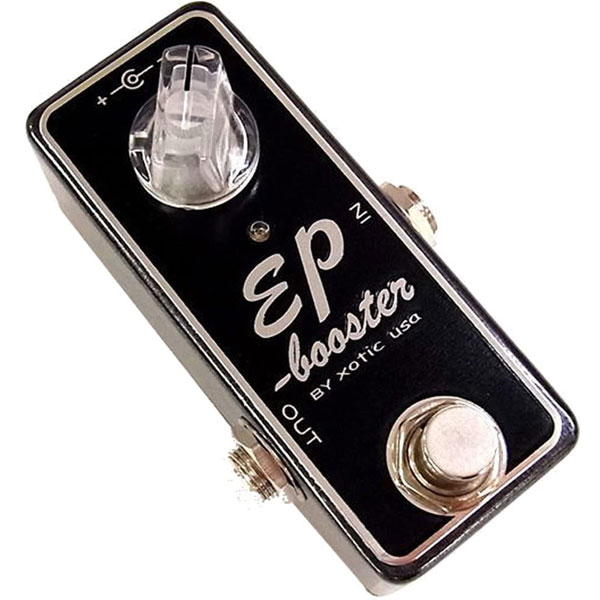
| Estimated Price | $130 |
| Type | Analog |
| Effects | Clean Boost, EQ |
| Connectivity | 1 x 6.35mm Jack Input, 1 x Output |
| Power | 9 Volt DC |
My Review: Many boost pedals claim to offer around 20 dB of gain, but I’ve found that not all of them can preserve the core tonal qualities of a clean guitar and amplifier sound. The EP Booster Mini by Xotic delivers on this promise.
With a classic FET design and an impedance output on the lower side, this pedal keeps the bass, mid and high-end frequencies of your clean tone intact whilst boosting the gain considerably.
Who is this best suited for: The Xotic EP Booster Mini is a great tool for guitarists who want a quick and simple way to raise their clean tone above the mix.
Bottom Line: With internal switches which allow you to shape the EQ of your clean guitar sound, the Xotic EP Booster Mini is a versatile boost pedal that is well suited to all genres of guitar playing.
17. VSN Booster
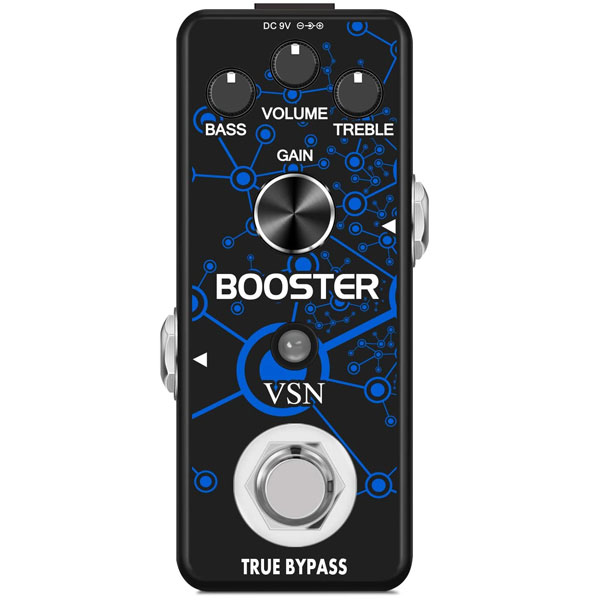
| Estimated Price | $30 |
| Type | Analog |
| Effects | Clean Boost, EQ |
| Connectivity | 1 x 6.35mm Jack Input, 1 x Output |
| Power | 9 Volts DC |
My Review: The VSN Booster is an affordable device with an array of dynamic and tone-shaping parameters. I was particularly impressed by the versatility of this pedal, and the various ways it can be used within the signal chain.
By using the bass and volume controls, you can ensure that your guitar’s clean tone doesn’t become too bright or muddy. Additionally, the gain control can be used to add heat to the signal, which sounds great with a tube amplifier.
Who is this best suited for: Guitarists looking for a boost pedal that also offers some EQ capabilities will find the VSN Booster very useful indeed.
Bottom Line: With a total of four rotary controls, true bypass switching, and a clear LED indicator, the VSN Booster is going above and beyond what you’d expect from a modestly-priced clean boost pedal.
Clean Boost Pedals – The Ultimate Guide
When performing live or recording, guitarists often need to boost their dynamics to be heard over the rest of the mix.
An easy way to boost your guitar’s output is by adding gain to the signal, which can be done by adjusting the settings on your amplifier or using a distortion-based pedal. The issue is that these methods also alter the tone of your guitar.
Clean boost pedals allow you to preserve the core tonal qualities of your guitar’s clean sound, whilst still providing you with the extra volume and clarity that you need. In the remainder of this guide, I’ll provide you with the information you need to ensure that you choose the best-suited clean boost pedal to add to your guitar rig.
Clean Boost vs. Dirty Boost
There are two types of boost pedals, which can often cause confusion amongst guitarists. One type is designed to boost the clean tone of the guitar, while the other type adds coloration in addition to the dynamic boost.
Some guitarists choose to employ overdrive pedals to provide a “dirty” boost. This is an effective way to add volume to the signal and make the guitar more prominent, but the tone is also altered due to the saturation that the pedal adds to the signal.
Clean boost pedals ensure that the natural clean sound of your guitar is retained after the signal has been boosted. They’re a great option for guitarists who often use their clean channel, perhaps most prominently in the genres of funk, jazz, or rhythm & blues.
Commonly Found Controls & Parameters
Like all effects, clean boost pedals come in a variety of forms. Some simply allow you to boost your guitar’s output using a single footswitch, with tone control. Others feature additional parameters, like EQ and Gain controls.
Here is an example of the controls you’re likely to find on a detailed clean boost pedal:
- Gain
- Treble
- Bass
- Volume
Due to the simplistic designs of most clean boost pedals, it’s very easy for guitarists to familiarize themselves with the controls. The extensiveness of the controls you’ll require depends on how you want to use your clean boost pedal.
If you’re looking for a device that will simply increase the volume of your guitar without making any tonal adjustments, it’s advisable to stick with a single-control designed boost pedal.
Alternatively, if there is a possibility that you would like to use the clean boost pedal to also add gain to your guitar’s signal, it might be a good idea to choose one which has onboard EQ and gain controls.
True Bypass vs. Buffered Clean Boost Pedals
If you have some experience in the field of effects pedals, you’ll probably be aware that they come in two varieties – true bypass and buffered. Both of these designs were invented to combat signal loss and maintain the strength of the signal as it passed through the chain.
However, despite the similar intended outcomes of true bypass and buffered pedals, the way they achieve this is quite different.
True bypass clean boost pedals combat signal strength loss by allowing the signal of the guitar to run through the inner circuitry of the pedal even when it is not engaged. This prevents the signal from becoming weaker as it travels through the rest of the chain.
Buffered clean boost pedals combat any noise or signal strength issues by essentially boosting the strength of the guitar’s signal. This boost allows the signal to run through the pedal without compromising on tone or volume. Buffering is constantly occurring whether the clean boost pedal is turned on or off.
If you’re using a mixture of true bypass and buffered effects pedals in your signal chain, it’s advisable to begin the chain with a buffered device. This will ensure that the signal is boosted slightly so that it retains its strength as it moves through the rest of the pedals in the chain.
True bypass pedals are highly effective when used with cable runs that don’t exceed 18.5 ft in length. Once this distance is exceeded, it’s best to incorporate some buffered pedals into the chain too, as this will ensure that the signal remains strong enough throughout the full extent of the chain.
Positioning a Clean Boost Pedal in Your Signal Chain
The key difference between a clean boost pedal and other volume-boosting effects such as overdrive and distortion is that you can place the boost in two positions in the signal chain. Firstly, the most common placement for a clean boost pedal is at the beginning of the chain, in front of your amplifier.
The advantage of placing the clean boost in this position is that it will blend more effectively with any gain-boosting effects that come after it in the signal chain. Positioning the boost after these effects would cause the cleanness of your tone to be compromised.
Another popular position of a clean boost pedal is in the amp’s effects loop. The effects loop, for those who are unfamiliar with this term, refers to separate input and output on an amplifier which allows you to isolate certain effects in between the preamp and power amp sections.
For boosting your clean tone, utilizing your amp’s effects loop is a very effective practice. Due to its isolation from other effects placed outside of the loop, the clean boost will sound clearer and purer, as it won’t need to contend with the other tone-shaping effects which make up your pedalboard.
Powering a Clean Boost Pedal
Most clean boost pedals can be powered either by using a 9 volt DC power supply, or a single 9 volt DC battery. If you’re adding a clean boost to a signal chain that already includes multiple pedals, it may be worth investing in a power brick, or PSU (power supply unit) as they are commonly called.
Using a PSU allows you to send power from a single unit into all of your effects pedals. These devices offer various voltage outputs, and they can be mounted to your pedalboard for added convenience.
Relying solely on batteries to power your clean boost pedal and other effects is risky, as there’s always a chance they could run flat mid-performance or halfway through the perfect recording take! Therefore, it’s best to use a power supply and only rely on batteries when mains power is not available.
Summary
There’s nothing quite like the sweet sound of a clean electric guitar. With so many pedals available which promise to transform your guitar’s tone beyond recognition, clean boost pedals offer a refreshing departure from this.
Now that you’ve read the information in this guide, you should be well equipped to choose the best-suited clean boost pedal for your requirements.

My name is Chris and I’ve had a passion for music and guitars for as long as I can remember. I started this website with some of my friends who are musicians, music teachers, gear heads, and music enthusiasts so we could provide high-quality guitar and music-related content.
I’ve been playing guitar since I was 13 years old and am an avid collector. Amps, pedals, guitars, bass, drums, microphones, studio, and recording gear, I love it all.
I was born and raised in Western Pennsylvania. My background is in Electrical Engineering, earning a Bachelor’s degree from Youngstown State University. With my engineering experience, I’ve developed as a designer of guitar amplifiers and effects. A true passion of mine, I’ve designed, built, and repaired a wide range of guitar amps and electronics. Here at the Guitar Lobby, our aim is to share our passion for Music and gear with the rest of the music community.
